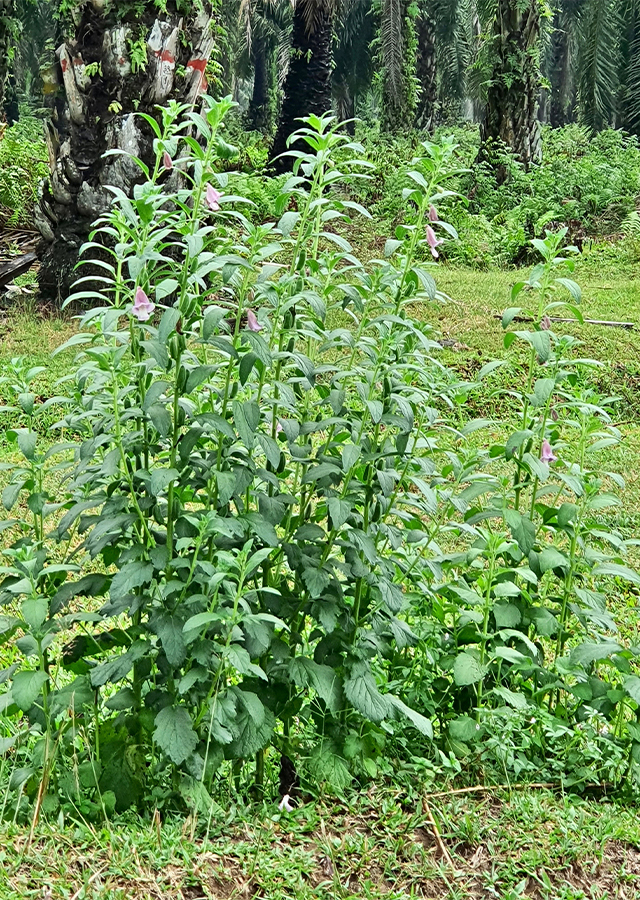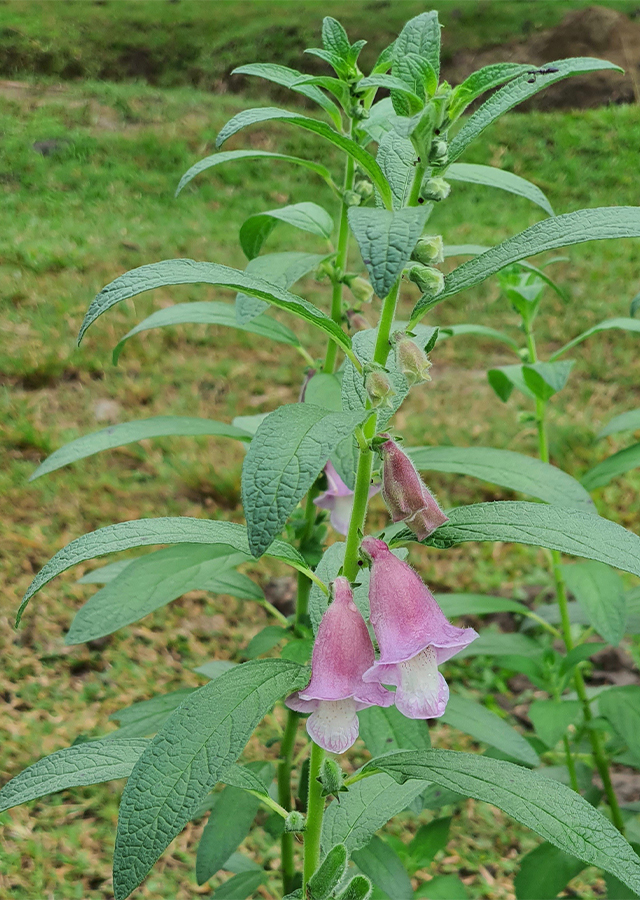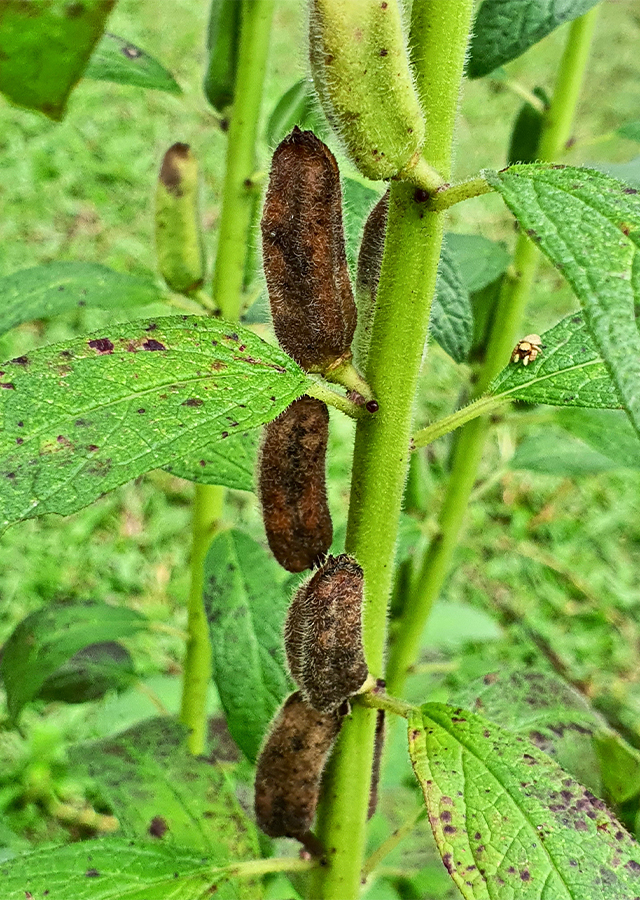Sesame
Sesamum indicum L.
Pedaliaceae
Location in our garden
Vegetable



Synonym
Strobilanthes gentiliana H.Lév.
Anthadenia sesamoides Lem.
Sesamum africanum Tod.
Habitus
Herbaceous. An erect, annual, hairy herb, 1-3 m in height
Part Used
Leaves
Seeds
Flowers
Roots
Growing Requirements
Need Shade
Habitat
Terrestrial
Overview
Beniseed is spread throughout the tropical and subtropical areas in Asia, Africa, and South America. It is commonly known as sesame is one of the oldest oilseed crops. It is used for its nutritional, medicinal, and industrial purposes. The plant has been cultivated for its edible seed and oil since at least 2.000 BC and also has a range of medicinal and other uses.
Vernacular Names
Wijen (Malaysia, Indonesia), Hu ma (Chinese), Gingli (Hindi), Graines de sesame (French), Nga kao (Thailand), Goma (Japanese), Sesam (German), Sesamzaad (Dutch)
Agroecology
Sesamum indicum can be grown from the warm temperature zone to the tropics. In the tropics, it can be grown at elevations up to 1.500 m. It grows best in areas where annual daytime temperatures are within the range of 20-30 °C. Prefers a mean annual rainfall in the range 500-1.000 mm, heavy rains may increase the incidence of fungal diseases. Requires a well-drained porous soil and warm sunny sheltered position. Succeeds in most well-drained soils of moderate fertility. Prefers a pH in the range of 5.5-7.5.
Morphology
- Roots - strongly tapering taproot up to 90 cm long.
- Stem - small, growing 50 to 100 cm, young stem with green color, sparsely hairy to glabrous.
- Leaves - oblong or ovate, 3-10 cm long, the lower ones lobed, the middle ones toothed, and uppermost subentire.
- Corolla - about 3 cm long, hairy and whitish, or with purplish, red, or yellow marks. The stamen is 4, inserted.
- Fruits - capsuled, 2-4 celled, oblong, about 2.5 cm long, erect, and splitting halfway or quite to the base at maturity.
- Seeds - pale brown or dark, flattened obovoid, 2-3 mm long, 0.5-1 mm thick,
Cultivation
Propagated by seeds - the seed can be stored for up two years with little loss of viability provided it is dried to below 8% moisture content and kept in airtight containers.
Chemical Constituents
- The seed contains fixed oil, 47-59%; saccharose, pentosan, lecithin; choline; phytine; globulin, 22%; sesamin.
- The oil consists of olein, linolein, palmitin, and stearin; fatty acids consist of oleic, linoleic, linolenic, palmitic, palmitoleic, stearic, eicosenoic.
- Nutritional value: carbohydrates 23.45 g, protein 17.73 g, total fat 49.67 g, dietary fiber 11.8 g, carbohydrates 23.45 g, copper 4.082 mg, iron 14.55 mg, magnesium 351 mg, manganese 2.460 mg, phosphorus 629, selenium 34.4 µg, zinc 7.75 mg, copper 4.082mg
- Secondary metabolites: saponin, alkaloids, flavonoids, glycosides, tannins, coumarins, and terpenoids.
Traditional Medicinal Uses
- Studies have shown antioxidant, anti-inflammatory, antidiabetic, anticancer, antihyperlipidemic, hepatoprotective, antileishmanial, gastroprotective.
- The seed is diuretic, emollient, galactagogue, lenitive, laxative, and acts as a tonic for the liver and kidneys.
- The leaves and seed are astringent, rich in the gummy matter and when mixed with water they form a rich bland mucilage that is used in the treatment of infant cholera, diarrhoea, dysentery, catarrh, and bladder troubles.
- The seed is taken internally in the treatment of premature hair loss and greying, convalescence, chronic dry constipation, dental caries, osteoporosis, stiff joints, dry cough, etc. It has a marked ability to increase milk production in nursing mothers.
- The oil promotes menstruation. It is used to treat dry constipation. mixed with lime water, the oil is used externally to treat burns, boils, and ulcers.
- The flowers are used to make an emollient tea.
- The root is emollient, a decoction is used in various traditions to treat asthma and coughs.
Part Used
Reference Sources
- Mbaebie, B., Omosun, G., Uti, A., and Oyedemi, S. 2020. Chemical Composition of Sesamum indicum L. (Sesame) Grown in Southeastern Nigeria and the Physicochemical Properties of the Seed Oil. Seed Science and Biotechnology, 4 (1): 69-72.
- Mkamilo, G.S., and Bedigian, D., 2007. Sesamum indicum L. [Internet] Record from PROTA4U. van der Vossen, H.A.M. & Mkamilo, G.S. (Editors). PROTA (Plant Resources of Tropical Africa / Ressources végétales de l’Afrique tropicale), Wageningen, Netherlands. <http://www.prota4u.org/search.asp>. Accessed 18-12-2021.
- Philipines Medicinal Plants. Linga. http://www.stuartxchange.com/Linga.html. Accessed on 18-12-2021.


